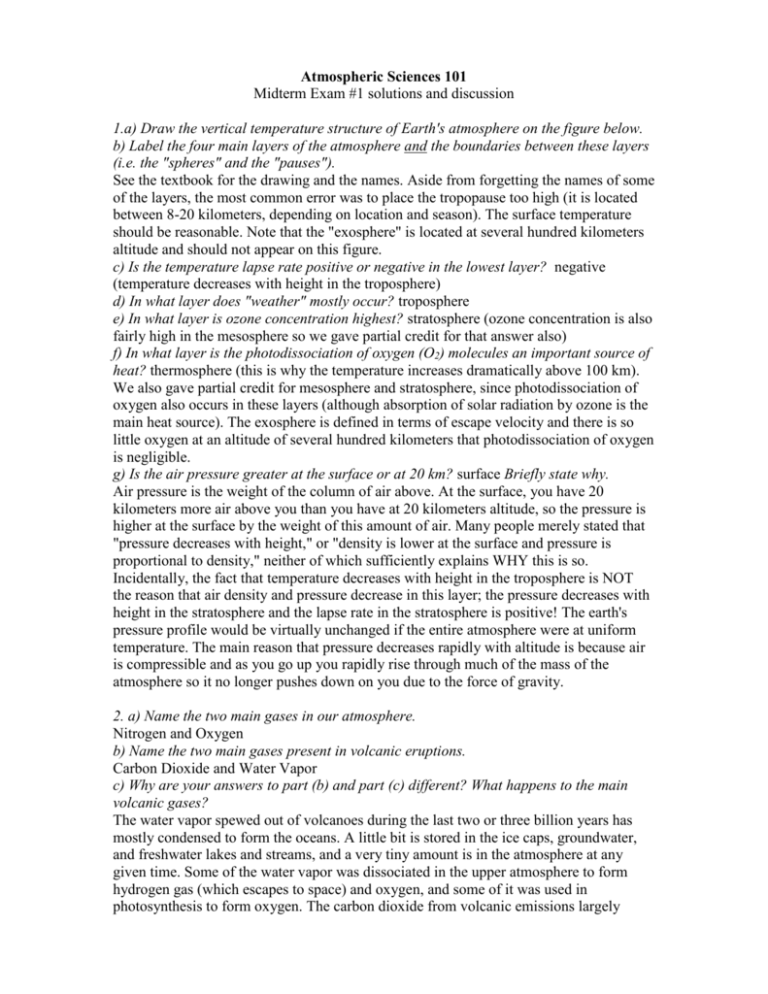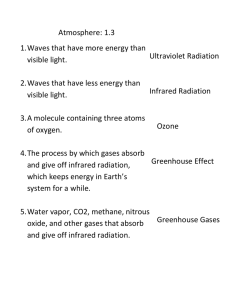Word - Atmospheric Sciences
advertisement

Atmospheric Sciences 101 Midterm Exam #1 solutions and discussion 1.a) Draw the vertical temperature structure of Earth's atmosphere on the figure below. b) Label the four main layers of the atmosphere and the boundaries between these layers (i.e. the "spheres" and the "pauses"). See the textbook for the drawing and the names. Aside from forgetting the names of some of the layers, the most common error was to place the tropopause too high (it is located between 8-20 kilometers, depending on location and season). The surface temperature should be reasonable. Note that the "exosphere" is located at several hundred kilometers altitude and should not appear on this figure. c) Is the temperature lapse rate positive or negative in the lowest layer? negative (temperature decreases with height in the troposphere) d) In what layer does "weather" mostly occur? troposphere e) In what layer is ozone concentration highest? stratosphere (ozone concentration is also fairly high in the mesosphere so we gave partial credit for that answer also) f) In what layer is the photodissociation of oxygen (O2) molecules an important source of heat? thermosphere (this is why the temperature increases dramatically above 100 km). We also gave partial credit for mesosphere and stratosphere, since photodissociation of oxygen also occurs in these layers (although absorption of solar radiation by ozone is the main heat source). The exosphere is defined in terms of escape velocity and there is so little oxygen at an altitude of several hundred kilometers that photodissociation of oxygen is negligible. g) Is the air pressure greater at the surface or at 20 km? surface Briefly state why. Air pressure is the weight of the column of air above. At the surface, you have 20 kilometers more air above you than you have at 20 kilometers altitude, so the pressure is higher at the surface by the weight of this amount of air. Many people merely stated that "pressure decreases with height," or "density is lower at the surface and pressure is proportional to density," neither of which sufficiently explains WHY this is so. Incidentally, the fact that temperature decreases with height in the troposphere is NOT the reason that air density and pressure decrease in this layer; the pressure decreases with height in the stratosphere and the lapse rate in the stratosphere is positive! The earth's pressure profile would be virtually unchanged if the entire atmosphere were at uniform temperature. The main reason that pressure decreases rapidly with altitude is because air is compressible and as you go up you rapidly rise through much of the mass of the atmosphere so it no longer pushes down on you due to the force of gravity. 2. a) Name the two main gases in our atmosphere. Nitrogen and Oxygen b) Name the two main gases present in volcanic eruptions. Carbon Dioxide and Water Vapor c) Why are your answers to part (b) and part (c) different? What happens to the main volcanic gases? The water vapor spewed out of volcanoes during the last two or three billion years has mostly condensed to form the oceans. A little bit is stored in the ice caps, groundwater, and freshwater lakes and streams, and a very tiny amount is in the atmosphere at any given time. Some of the water vapor was dissociated in the upper atmosphere to form hydrogen gas (which escapes to space) and oxygen, and some of it was used in photosynthesis to form oxygen. The carbon dioxide from volcanic emissions largely dissolved into the oceans, where much of it was converted into calcium carbonate by tiny ocean creatures whose remains became sedimentary rock. Some of the carbon dioxide is also tied up in living plants and animals and in oil and coal deposits. You didn't need to explain the origin of nitrogen and oxygen, but partial credit was given if you did this instead. Nitrogen is present in volcanic emissions in small concentrations, but because it is essentially inert its concentration has slowly built up over geologic time. Oxygen is formed from the photodissociation of water vapor (small amount) and from photosynthesis (main contributor). 3. a) Define heat. The total internal kinetic energy of a collection of molecules b) Define temperature. The average internal kinetic energy of a collection of molecules c) Give an example of heat transfer by "convection". Thermals in the atmosphere, water in a pan heated from below, etc. d) Give an example of heat transfer by "conduction" Snow melting on the hood of a warm car, a spoon in a hot bowl of soup gets warm, etc. e) Give an example of reflection of visible radiation. A mirror reflects virtually all visible radiation; you "see" most things via the reflection of visible radiation off of them. f) Give an example of emission of infrared radiation. The earth, or any other mass above absolute zero, constantly emits infrared radiation. g) Give an example of absorption of infrared radiation. Clouds and greenhouse gases absorb a lot of the infrared radiation emitted by the earth. h) Define albedo. The percentage of incident (incoming) electromagnetic radiation reflected by something. 4) On this sketch of the Earth, five points at different latitudes are indicated by the letters A, B, C, D, and E. The earth is tilted at 23.5 degrees from its orbital plane, and the sun is located very far away on the right side of the figure. The thin dashed line surrounding the planet represents the Earth's atmosphere. a) What season is depicted in this sketch? (Circle one) Northern Hemisphere Summer b) Rank each point (A-E) by the duration of daylight at that latitude during this season. A, B, C, D, E c) Which location is receiving the most intense solar radiation at noon at the top of the atmosphere? B Which location is receiving the least intense solar radiation at noon at the top of the atmosphere? E d) List two reasons why the radiation received at the surface might be different than the radiation received at the top of the atmosphere at point A. Scattering by the atmosphere or aerosols, reflection by clouds, absorption by ozone. We did NOT ask you to compare point A with any other point on the diagram, which confused many people. Common answers included "path length" or "zenith angle", but these are insufficient without explaining WHY a long path length through the atmosphere or a large zenith angle would reduce the amount of solar radiation received at the surface versus the top of the atmosphere. The area covered by the solar beam (ala the laser pointer demonstration) is the same at the surface and the top of the atmosphere, so this cannot explain the difference in radiation received. Also, the fact that the top of the atmosphere is slightly closer to the sun produces a negligible difference in solar intensity. 5. a) Define "selective absorber". A gas that absorbs electromagnetic radiation efficiently at certain wavelengths but transmits (does not absorb) radiation at other wavelengths. Watch out for the following mistakes: - Gases absorb radiation, and not vice versa. - Selective absorbers absorb radiation at certain wavelengths, but do not "reflect" radiation at other wavelengths! They transmit the other; if radiation at the other wavelengths were reflected, then nothing would ever reach the surface of the Earth! - A selective absorber is a gas. Aerosols and objects may absorb radiation, but they do not fall into the "selective absorber" category. - Water vapor is a selective absorber (it is actually the most important one for the greenhouse effect on Earth), but clouds are made of water droplets (not water vapor), and thus they are not referred to as "selective absorbers." In the Earth's atmosphere, we usually deal with two types of selective absorbers: gases that absorb UV (ultraviolet) radiation, such as ozone, and gases that absorb IR (infrared) radiation, such as water vapor and CO2. Ozone absorbs UV radiation from the Sun and prevents it from reaching the surface of the Earth, whereas water vapor and CO2 absorb IR radiation from the Earth and contribute to the Greenhouse effect. (Ozone also absorbs some IR radiation emitted by the earth, but its main impact on the Earth's climate is due to the absorption of solar UV radiation.) b) Name three important selective absorbers present in our atmosphere and circle the most important one. Water vapor (most important), ozone, carbon dioxide, methane, chlorofluorocarbons (CFCs),... c) The following figure shows the absorption spectrum of the Earth's atmosphere with all gases normally present in the atmosphere taken into account. Indicate the "atmospheric window" on the figure (Hint: it is located in the infrared portion of the spectrum). The (infrared) atmospheric window is located between the wavelengths of 8 to 12 microns. Watch out! The visible atmospheric window is in the visible part of the spectrum between 0.3-0.7 microns. When we just say "atmospheric window," we are talking about the infrared atmospheric window. Make sure that you can locate the visible and infrared wavelengths on a spectrum of electromagnetic radiation. Also, a "window" is a part of the spectrum where the absorption is close to 0% (the radiation can go through), not close to 100%. d) If a large amount of gas X was added to the stratosphere (and it remained there indefinitely), how would you expect the temperature of the stratosphere to change? Why? The temperature of the stratosphere would increase because gas X would absorb some of the visible radiation coming down from the Sun. We do not know exactly how much the stratosphere would heat up without knowing exactly how much gas X was put into the stratosphere, but since we added a large amount we would expect the temperature increase to be significant. The radiant energy absorbed by gas X would be transformed into internal kinetic energy of the gas X molecules, which is heat. This heat would quickly spread to all the other molecules in the stratosphere as the molecules bump into each other. e) How would you expect the amount of solar radiation received at the surface of the Earth to change if a large amount of gas X was added to the stratosphere? Why? Less visible radiation would be reaching the surface because gas X is absorbing some (or maybe most) of it in the stratosphere. f) Just considering the change in shortwave radiation received at the surface due to the presence of gas X in the stratosphere, how would you expect the surface temperature of the earth to change? Less energy is reaching the ground (less visible radiation is able to pass through the atmosphere), so the surface would cool. We asked you to just consider the change in shortwave radiation; you should only take into account the change in visible radiation reaching the surface, and not the infrared emission from the surface. g) If a large amount of gas Y were added to all levels of the atmosphere (and it remained there indefinitely) how would the Earth's surface temperature change? Why? Gas Y is a strong greenhouse gas, since it absorbs infrared radiation very efficiently but it does not absorb any shortwave radiation. Thus it would absorb much of the infrared radiation emitted by the Earth's surface and re-radiate some of this energy back to the ground. This would create an excess of energy at the ground and the Earth's surface would heat up. When it heats up, it emits more infrared radiation, so gas Y would absorb more radiation and re-emit it, and so on. This would continue until the radiation received at the Earth's surface balances the radiation emitted by the surface. Gas Y acts just like the glass in a greenhouse--it would be an important greenhouse gas. By the way, it is incorrect to assume that infrared radiation is the only source of heating. The surface of the Earth is heated by both the incoming visible radiation from the Sun and the infrared radiation from the gases of the atmosphere. 6. a) If you were lying on the beach around 4:00 p.m. on a sunny summer afternoon, would you expect the sand or the ocean to have the highest temperature? Which would you expect to be warmer at 4:00 a.m.? Explain your answers in a few short sentences. This problem is similar to the Seattle-Spokane example we did in lecture. Remember that the specific heat of water is high (1 calorie per gram per degree Celsius). In particular, the specific heat of water is much higher than the specific heat of dirt or sand (on the beach). This means that it takes a lot more energy to raise the temperature of water than it does to raise the temperature of sand. Thus if water and sand receive the same amount of energy, the temperature of the sand will rise more than the temperature of the water. Since the sun has been providing the same amount of energy to the sand and the water on a sunny summer day, the sand is a lot warmer than the water by 4 p.m. (Note that the sand does not receive more energy; it just gets warmer when it receives the same amount of energy). The other reason that the sand is warmer at 4 p.m., which you needed to mention for full credit, is that the heat absorbed by the ocean is mixed down into the rest of the ocean by turbulence (down to approximately 50 meters), whereas the heat absorbed by the sand remains in the first few centimeters below the surface. Thus the effective specific heat of a few centimeters of sand is much, much less than the specific heat of 50 meters of ocean. During the night, the energy is lost by the sand more quickly than it is by the water, again because the specific heat of sand is much less than water and because only a few centimeters of sand needs to cool instead of 50 meters. Thus the sand will be cooler than the ocean by the end of the night. b) Explain the difference between the "greenhouse effect" and "greenhouse warming". Make sure that you mention what factors are responsible for each of these phenomena. The Earth is in radiative equilibrium. All of the energy received from the Sun (mainly in the form of visible radiation) is re-emitted by the Earth in the form of infrared radiation. Since selective absorbers such as carbon dioxide, water vapor, and other gases are present in the atmosphere which absorbs radiation in the same range of wavelengths that the Earth emits, part of the infrared radiation emitted by the surface of the Earth is absorbed by that selective absorber, and partly reemitted toward the surface, absorbed by the surface, and so on. The net effect is a "trapping" of this energy in the lower atmosphere, and an increase of the temperature of the surface of the Earth (see answer to (5g)). Remember, once again, that water vapor is the main selective absorber responsible for the greenhouse effect, and not carbon dioxide. The key point here was to emphasize that the "greenhouse effect" is a natural phenomenon, and that "greenhouse warming" is an enhancement of the greenhouse effect by different factors. Recently (mainly during the last century), we have significantly increased the amount of fossil fuel burning, increasing the amount of carbon dioxide in the atmosphere. These "anthropogenic" sources of carbon dioxide (from "anthropos"=man, "gen-"=create, generate) are responsible for an increase in the greenhouse effect, which we refer to as "greenhouse warming"








